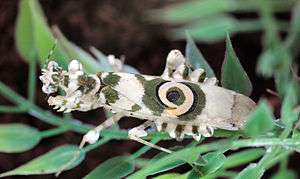Pseudocreobotra wahlbergi
| Pseudocreobotra wahlbergi | |
|---|---|
 | |
| Spiny Flower Mantis adult | |
| Scientific classification | |
| Kingdom: | Animalia |
| Phylum: | Arthropoda |
| Class: | Insecta |
| Order: | Mantodea |
| Family: | Hymenopodidae |
| Genus: | Pseudocreobotra |
| Species: | P. wahlbergi |
| Binomial name | |
| Pseudocreobotra wahlbergi Stål, 1871 | |
Pseudocreobotra wahlbergi, or spiny flower mantis, is a small Flower Mantis (1.5 inches or 38 millimetres) native to southern and eastern Africa.
Description
The adult has spiny structures on the underside of its abdomen, giving it its name. It is variable in colour, being typically greenish, but it can equally be yellowish, pinkish or reddish. It has a striking spiral "9" mark on its forewings providing a conspicuous eyespot in black, green and cream surrounded by a green patch. The hind wings are orange on the inner part and transparent on the outer part. The species is common in captivity and is easy to rear. The female lays egg cases almost three times its size.[1]
Behaviour and ecology
P. wahlbergi has a deimatic display in which it spreads its forewings, making itself appear larger and prominently displaying its eyespots to startle would-be predators. While at rest it is well camouflaged, and is a sufficiently good aggressive mimic of a flower that prey insects can attempt to pollinate it, at which moment the mantis seizes and eats them. The mantis is able to kill prey several times larger than itself.[1]
See also
References
- 1 2 Deadly Mantis. Retrieved 13 May 2013.